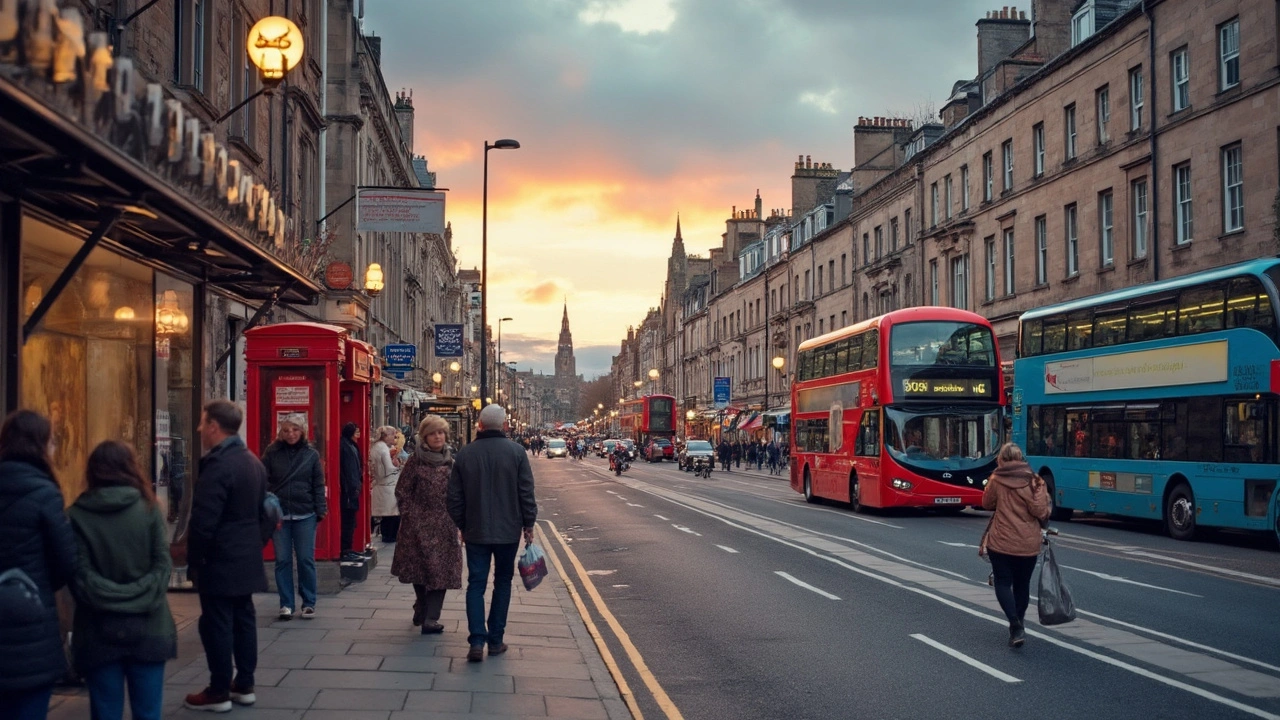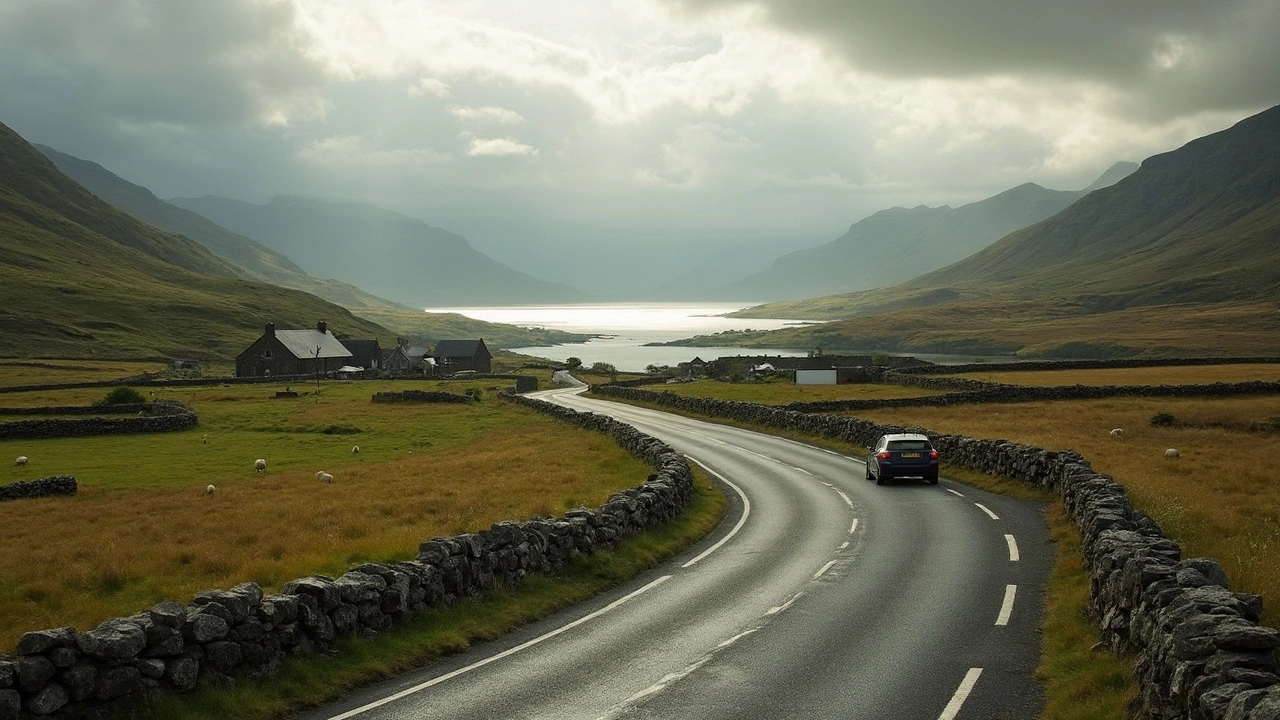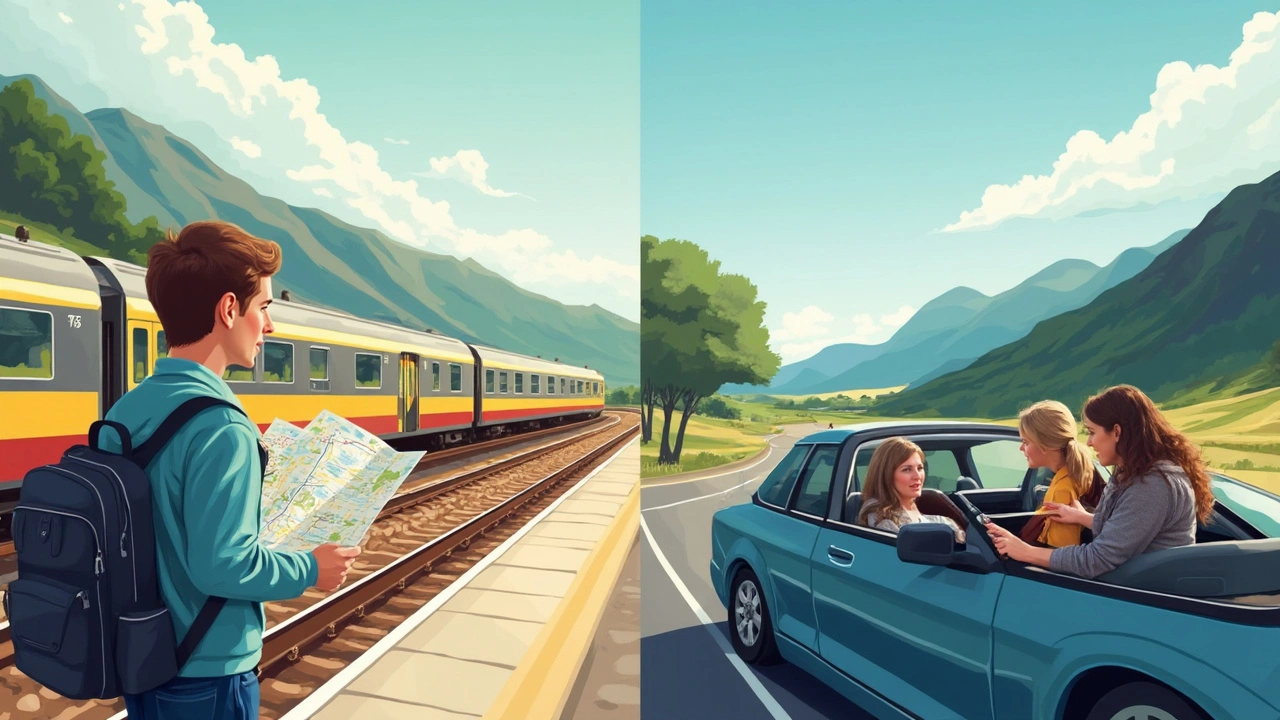
So, do you actually need a car in Scotland? Spoiler: It’s not as clear-cut as you might think. Imagine this—standing at the edge of Loch Ness, mist curling over the water, but you got there by bus, not a hire car. Wild, right? And yet, for many folks—locals, expats, students, and anyone over for a life-changing holiday—this question comes up over a pint almost every week. Let’s get brutally honest: Scotland isn’t some wild, inaccessible moorland that only rugged off-roaders can crack. Google Maps and a dash of patience open a lot more of the country than you’d guess. But, there’s always a but…
Public Transport in Scotland: Does It Really Work?
People love to moan about Scotland’s transport but hear me out. Buses, trains, and even ferries cover a solid chunk of the country. Take the ScotRail network: It connects most decent-sized towns and cities, and I can get from Dundee to Edinburgh Waverley in about an hour and twenty minutes. If you stick to urban areas—think Glasgow, Edinburgh, Aberdeen, Dundee—you can do nearly anything without a car. Trains rumble by every half hour between the big cities. Every village doesn’t have a station, but regional buses (Stagecoach, Citylink, Lothian Buses in Edinburgh) do a fair job outside the most far-flung areas. The best bit? The stunning scenery from the train window—try the West Highland Line to Mallaig and tell me you didn’t get chills.
Here’s a quick look at how Scotland’s public transport stacks up in regular life:
| City | Public Transport Options | Frequency (weekday) |
|---|---|---|
| Glasgow | Train, Subway, Bus | Every 5-15 mins |
| Edinburgh | Train, Tram, Bus | Every 7-20 mins |
| Dundee | Train, Bus | Every 15-30 mins |
| Inverness | Train, Bus | Every 30-60 mins |
| Isle of Skye | Bus, Ferry | Every 1-3 hours |
Honestly, things get pinchy once you hit the really rural bits. Going up to places like Glenelg or the North Coast 500 by bus can mean waiting two hours between rides—or worse, missing the last one back and chatting to sheep until Monday. Ferries connect islands (CalMac is the name to remember), but these don’t run late, and bad weather can cancel crossings. Google "Scotrail strikes" or "CalMac disruptions" to see how things can go sideways fast.
Still, if your plan is to work, study, or hang out in a city, you’ll rarely wish for a car. Most folk in Edinburgh or Glasgow find parking a bigger headache than any bus delay. Parking costs can be jaw-dropping—for example, three hours near Princes Street can set you back over £10. Add insurance, MOT, and fuel, and city dwellers often drop the car keys. It’s also worth noting, Scotland’s trains are among the priciest per mile in Europe, but monthly or student passes take the sting off. The tap-on tap-off buses in Edinburgh are especially slick, and you’ll almost always get Wi-Fi.
Pro tip: Download the Traveline Scotland app or their journey planner—it’s a lifesaver for routes and real-time updates. Student? Look for Young Scot or 16–25 Railcards. Young people can save a fortune. For families, group day tickets can make day trips doable without costing lunch money.

When a Car Makes Life Easier in Scotland
Now, what about those epic, out-of-the-way places? Here’s the unvarnished truth—you’ll want a car if you crave freedom, hate waiting, or love staying late in the hills with a flask of tea. Rural Scotland is properly scattered. Some of the wildest bits—think Sutherland, Assynt, or little bothies along single-track west coast roads—barely see a bus. Fancy midnight stargazing at Glencoe or a weekend camping somewhere you only find on OS maps? Hope you're happy to either pay for taxis or plan carefully with the rare bus times.
Driving in Scotland is a strange mix of joy and hair-raising moments. One second, you’re cruising by castles and lochs, next you’re negotiating a flock of sheep or slowing down for a wandering red deer. People coming from outside the UK (especially Americans) are often floored by what we call “single-track roads”—country lanes barely wide enough for one car, let alone two. Luckily, there are small passing places every few dozen yards, and locals are friendly about letting you pass or waving thanks. Rural petrol stations tend to close early, and pumps can be far apart. Plan ahead, especially up north.
Not every trip is a Highlands epic though. Loads of local families in places like Stirling, Oban, or St Andrews genuinely need a car for work. There just isn’t enough public transport for all those "last mile" journeys—picking up kids, shifts that run late, or quick dashes between scattered villages. If you live somewhere like East Lothian or Fife countryside, having a car is just more practical. A 2023 government study found that outside Scotland’s five biggest cities, over 78% of households use their car at least weekly. City numbers are dropping but go rural and almost every drive counts.
Cost’s a biggie, though. Fuel prices here are never shy. Diesel and petrol hover around £1.50 to £1.70 per litre. Add MOT, insurance, yearly road tax, and you’re talking £2000–£3000 a year for even a modest runabout. Car clubs are sneaking in—Co-Wheels and Enterprise Car Club let you rent a car by the hour, perfect for holiday guests or locals with only occasional car needs. The EV (electric vehicle) charging network in Scotland is actually ahead of the curve for the UK, thanks to ChargePlace Scotland, but in really rural bits it’s wise to check ahead before banking on a charger.
Tourists renting a car? The rules are simple: automatic cars cost more and book up faster. Learn the basic signs—turn left at roundabouts, not right! Don’t try to park in city centres in August (Edinburgh Festival is a madhouse). The Scottish drink-driving limits are stricter than England. If you’re stopped, even a pint might tip you over the legal blood-alcohol level (to 0.05%). Take it steady.
- Get familiar with single-track road etiquette: use passing places, don’t block them, and wave in thanks when locals let you pass.
- If you hit wildlife or break down, signal for help and call for a local recovery—never just wait and hope.
- Bring a physical road map. Phone signal drops in many wild spots.
Parking in small towns is usually free but can get packed in summer, especially with visiting campervans. Speaking of those—motorhomes are huge for rural adventures, but not every site welcomes “wild camping” in them. Check Scottish Outdoor Access Code rules before pitching up. The same goes for leaving litter or campfires: Scots love their land, so mind the environment. Avoid blocking farm entrances and passing places.

City Life, Commuting, and Local Secrets
If you’re new to Dundee like I once was, or moving to any city here, join the club—urban living rarely demands a car. In fact, I ditched mine three years ago and honestly don’t miss it much. Bike hire schemes have exploded—look for e-bikes in Glasgow, Nextbike or Lime in Edinburgh, and even smaller cities like Dundee and Perth are investing in cycle paths. On most main roads, cycling feels safe by UK standards. And thanks to free buses for under-22s (and over-60s), a lot of people are letting their cars gather cobwebs.
Here’s something you won’t find in travel brochures: Scottish cities are pretty walkable. Edinburgh’s Old Town, Aberdeen’s granite lanes, Glasgow’s West End—they’re all close-knit and packed with life. You can cross Dundee’s city centre in about 15 minutes. Even the rain is less miserable when you’re dodging between record shops and coffee bars. For people with disabilities, the transport infrastructure is a mixed bag—most train stations are step-free, but rural buses don’t always have ramps. Taxis regularly offer wheelchair-friendly options, but best to phone ahead.
Commuting by public transport? Outside of rare rail strikes, things are alright, but you will grumble at the odd late train or bus. The 07:47 to Glasgow is a rite of passage and usually packed with grumpy folk clutching Greggs coffee. Fridays before big football games, trains are a party (if you’re up for it).
Students are set. Between cheap bus passes and easy access to campuses, very few bring cars, especially in places like St Andrews or Edinburgh. In fact, some university halls ban student parking. If you’re thinking long-term, living in a city with no car frees up cash for weekend mini-breaks—train tickets to Aviemore for hiking or the Borders for rugby.
One more thing—a big reason people in cities ditch their cars is traffic. Glaswegians love to groan about the Kingston Bridge at rush hour. From 2022, Low Emission Zones (LEZs) kicked in for the four big cities. Older petrol and diesel cars get stung with fines (or just banned) if they enter the central zones. The goal? Clean up air and push biking/buses for everyone. I won’t lie, this has changed the game—especially for out-of-town workers.
Here are a few handy tips if you’re trying to get around Scottish cities:
- Check if your car meets Low Emission Zone rules—especially in Edinburgh, Glasgow, Aberdeen, Dundee.
- Buy a transport smartcard (like Oyster in London)—makes commuting faster and cheaper.
- Bikes are free on most rural trains but need a £3 booking on Caledonian Sleeper.
- City bike schemes are great for last-minute dashes.
- Bus lanes are flogged by traffic cameras—habitual lane hoppers risk nasty fines.
Scotland’s taxi ecosystem is reliable for city life—black cabs, Uber, and a raft of local firms. Night buses roll through the main arteries, especially in Glasgow and Edinburgh. If you want the pure local insider tip: the last bus or train on a Saturday can be a rollicking slice of Scottish life. Don’t miss it, but pack earplugs just in case.
So, do you "need a car in Scotland"? The honest answer is—it depends on how far you need to go, how patient you are, and whether you’d rather watch stunning countryside from a train or take the wheel yourself. Either way, the adventure is built right in.
Comments (10)
-
Ronnie Kaye July 17, 2025
Man, the question of owning a car in Scotland really depends on where you are and what you want out of life, right?
If you're stuck in big cities like Edinburgh or Glasgow, I'd argue a car is more of a hassle than a help—traffic jams, pricey parking, and don't even start me on narrow streets with wild roundabouts.
But if you’re aiming to explore the Highlands or remote areas, nothing beats having your own set of wheels. Public transport there can be, well, let's just say it requires the patience of a saint.
Also, can we talk about how gorgeous the drives are? I mean, the scenery alone might make sitting behind the wheel worth it despite the more challenging driving conditions.
That said, the guide's nod to Dundee experiences is spot on—local tips like these make or break your decision.
Honestly, it boils down to your style: city rat vs. roaming adventurer.
Either way, props to the author for laying it all out so clearly!
-
Priyank Panchal July 20, 2025
Look, owning a car in Scotland? It's a double-edged sword, no sugarcoating it.
For urban life, public transport should suffice, period. Buses and trains cover most major routes, and if you insist on driving in city centers, get ready for stress and heavy traffic fines.
However, when it comes to rural or highland travel, a car is essential. The distances are vast, and waiting hours for buses in the cold is out of the question.
The guide did well calling out that no one-size-fits-all solution applies here.
One thing, though—never underestimate the driving skills required; Scottish roads can be unforgiving for newbies.
So if you don't have the experience, either learn fast or stick to public transport.
Simple and straightforward.
-
Ian Maggs July 21, 2025
Ah, the perennial question: To own or not to own a car in the enigmatic lands... of Scotland.
What an exquisite dilemma! One must weigh not merely the utilitarian factors but also the philosophical implications of mobility and freedom.
Consider the subtle elegance of the public transit system as an interconnected web—a dance of coordination across urban and rural spheres.
Yet, is it not true that only when one embraces the solitary journey upon the winding roads can one truly commune with the spirit of this ancient landscape?
The article delicately balances pragmatism with the romance of travel, and I say, bravo.
In essence, the question begs us to reflect deeply on what autonomy means in this age of shared mobility.
More than a practical guide—it's a meditation of sorts. Fascinating!
-
Michael Gradwell July 22, 2025
Honestly, my take is pretty straightforward: if you're someone who values efficiency and hates wasting time, owning a car in Scotland is the way to go.
Public transport can feel like a patchwork solution that leaves you stranded when you most need reliability.
Especially outside the cities, you risk losing hours waiting or being limited by schedules.
Now, I get the appeal of being environmentally conscious, but convenience shouldn't be sacrificed at the altar of virtue.
Driving yourself gives control—every trip, every detour on a whim.
The author gets it right by pointing out the different needs for locals vs. visitors.
So yes, if your days involve real travel beyond the tourist spots, buy that car.
-
Flannery Smail July 23, 2025
I've gotta say, I'm not entirely buying the hype about needing a car in Scotland at all.
I've lived in cities with much worse transport systems, and the buses and trains in Scotland are pretty decent.
Plus, owning a car comes with its own headaches—insurance, maintenance, parking nightmares.
People romanticize the 'stunning roads' thing, but honestly, that’s for the weekend warriors, not the daily slog.
If you're smart and plan your trips using public transit, you'd save money and hassle.
Sure, rural areas might need a car, but let's be real, not everyone lives there.
Don't fall for the 'car or nothing' mentality—there are good alternatives.
-
Emmanuel Sadi July 23, 2025
Oh great, another article pretending Scotland is some two-dimensional land where cars or buses are the only choice.
Newsflash: owning a car isn't for everyone and definitely not a solution for travel woes.
The point about 'stunning roads' is laughable because it doesn't mention that many of these roads are narrow, twisty, and downright dangerous.
Plus, the costs of car ownership? You're basically throwing money into a black hole for some fake freedom.
If you really want to explore, there's hiking, cycling, and local tours that don't require you to bankrupt yourself.
Let's stop pretending buying a car is the only way to appreciate Scotland.
This guide borders on lazy advice in some parts.
-
Nicholas Carpenter July 24, 2025
I appreciate this post breaking down the nuances for locals and visitors separately.
Having lived in Scotland for a year, I found owning a car invaluable for weekend trips and rural stays, especially when public transport was sparse or infrequent.
That said, city life felt much easier without the worries of parking and traffic.
The guide’s practical tips on what to expect and how to plan transport choices struck a good balance between idealism and reality.
My suggestion for visitors: weigh your itinerary carefully—urban exploration vs countryside adventure—and decide accordingly.
Renting a car for parts of a trip might be the cheapest and most flexible solution.
It’s all about fitting your transportation to your needs and comfort level.
-
Chuck Doland August 1, 2025
This post offers a commendable exploration into the practical and logistical considerations inherent in owning a vehicle within Scotland.
From an analytical standpoint, the varying urban densities and infrastructural diversities make a one-size-fits-all recommendation rather untenable.
It is imperative to consider demographic mobility patterns, weather contingencies, and regional public transit efficacy when deciding.
The author’s amalgamation of personal anecdote and empirical data from Dundee and beyond provides a balanced framework to guide decision-making.
Moreover, the delineation between resident and visitor needs substantially enriches the discourse.
I would, however, recommend supplementing this with a cost-benefit analysis of long-term car ownership versus transient rental options.
Nonetheless, a thorough and insightful contribution to an often overlooked subject.
-
Madeline VanHorn August 4, 2025
Honestly, owning a car in Scotland is such a mixed bag it’s almost laughable to make a universal call here.
If you’re a local stuck in a tight city like Glasgow, you’re better off ditching the car and walking or taking the bus.
Too much hassle, and honestly, no one has that much time to waste dealing with parking or traffic.
Visitors, on the other hand, should definitely consider whether their itinerary is more about city life or rural escapades because that makes all the difference.
Public transport is clean and decent in most places, but don’t expect miracles in the Highlands.
The piece does a nice job highlighting these nuances but maybe underplays how costly and stressful owning a car can be.
Keep that in mind before signing any papers.
-
Glenn Celaya August 8, 2025
As someone who’s dealt with both and hated the complications, I find this subject really frustrating.
Cars in Scotland are like a necessary evil—too expensive, too complicated to park, too weather-dependent, and honestly, with public transport getting better, the argument for ownership weakens.
But then again, if you want to roam freely and hit those majestic spots no bus goes to, you’re stuck.
The author’s guide is pretty balanced but maybe a bit too polite about the downsides.
Also, for anyone who values convenience and peace of mind, just add up the real daily costs of owning a car in Scotland and see if it’s worth it.
I’m not convinced for urban dwellers.
Maybe for the adventurous types only.
